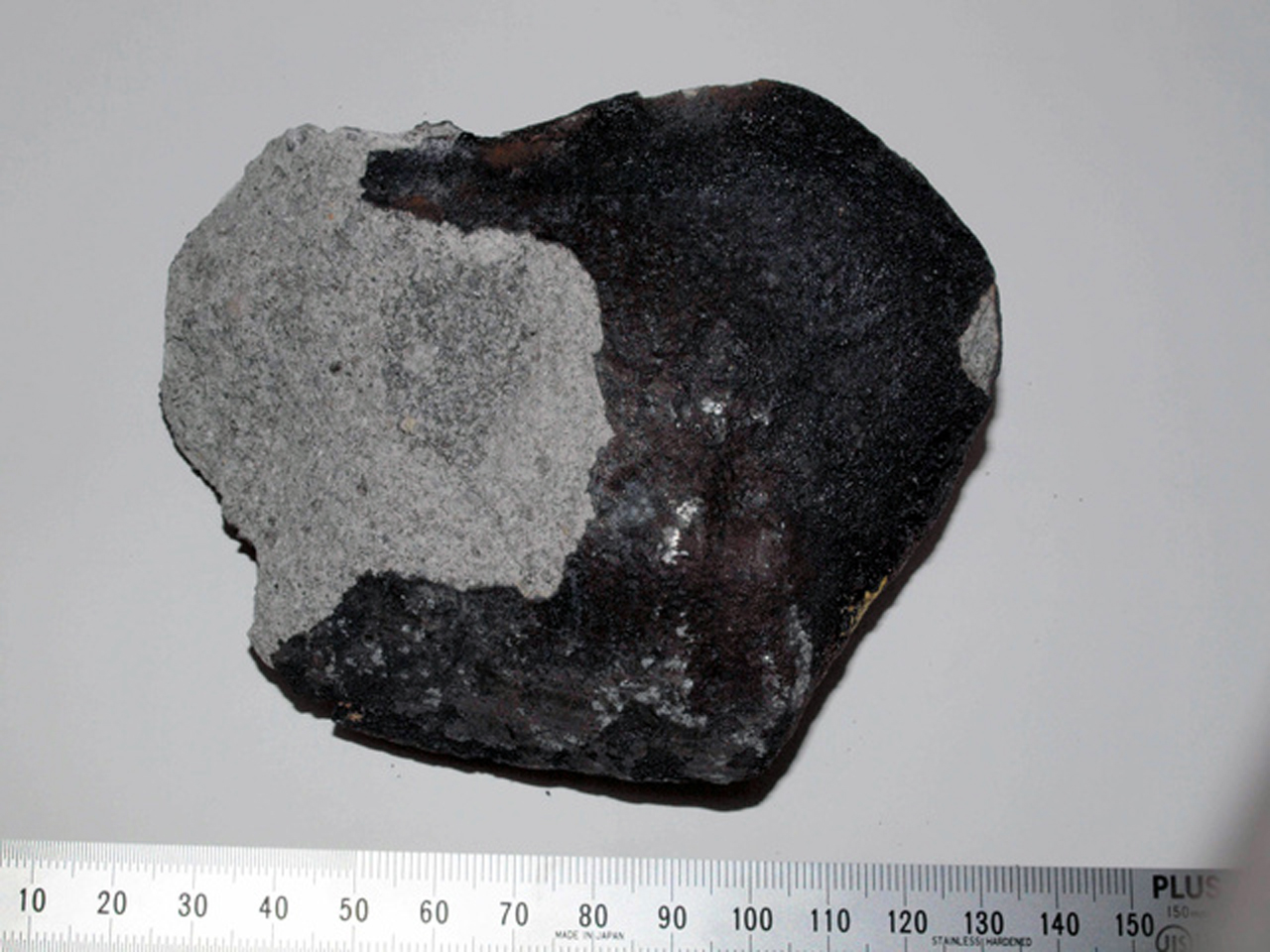Komaki meteorite fall (~ 654 g/L6/S3) on 26 September 2018 at ~10.30 p.m. JST (UTC+9) in Komatsuji (小松寺), Komaki (小牧市), Aichi (愛知) Prefecture, Chūbu (中部地方), Japan
Last update: 6 April 2019
 The meteorite, an ordinary chondrite, hit the roof of a house in Komatsuji (小松寺) Komaki-Shi (小牧市), Aichi (愛知) Prefecture, Japan on 26 September 2018 at around 10.30 p.m. JST (UTC+9). It fragmented into three larger (10.5/8.5/4.5 cm, ~ 5×5 cm (81 grams), ~ 4×3 cm) and at least 15 smaller fragments (~ 0.5 to 1.8 cm) on impact and left a hole in a roof tile near the roof ridge of the house. The woman living in the house at location 35°18’38.2″N, 136°56’58.4″E in Komatsuji (小松寺), Komaki-Shi (小牧市) reports that she heard a low-pitched sound which resonated in the house. The woman added she had been very surprised and had had goose bumps during the moment of impact. The following day (27 Sept.) she found a square-shaped crusted meteorite fragment with an edge length of about 5 centimeters weighing 81 grams in her yard. Furthermore, another crusted triangular-shaped meteorite fragment with a length of about 4 centimeters and several smaller crusted fragments were found on the roof of her garden shed on the southern side of her house. On 25 October the woman donated the 81-gram fragment to the National Science Museum. The woman is quoted* having said:
The meteorite, an ordinary chondrite, hit the roof of a house in Komatsuji (小松寺) Komaki-Shi (小牧市), Aichi (愛知) Prefecture, Japan on 26 September 2018 at around 10.30 p.m. JST (UTC+9). It fragmented into three larger (10.5/8.5/4.5 cm, ~ 5×5 cm (81 grams), ~ 4×3 cm) and at least 15 smaller fragments (~ 0.5 to 1.8 cm) on impact and left a hole in a roof tile near the roof ridge of the house. The woman living in the house at location 35°18’38.2″N, 136°56’58.4″E in Komatsuji (小松寺), Komaki-Shi (小牧市) reports that she heard a low-pitched sound which resonated in the house. The woman added she had been very surprised and had had goose bumps during the moment of impact. The following day (27 Sept.) she found a square-shaped crusted meteorite fragment with an edge length of about 5 centimeters weighing 81 grams in her yard. Furthermore, another crusted triangular-shaped meteorite fragment with a length of about 4 centimeters and several smaller crusted fragments were found on the roof of her garden shed on the southern side of her house. On 25 October the woman donated the 81-gram fragment to the National Science Museum. The woman is quoted* having said:
“偶然、小牧の私の家に落ちましたが、人類の貴重な財産なので寄付を決めました。研究者や宇宙に興味を持つ学生などに役立ててもらえばうれしいです”
(“By chance it fell on my house in Komaki, but I decided to donate because it is a valuable asset of mankind. It would be nice to have it used by researchers and students interested in space.”)
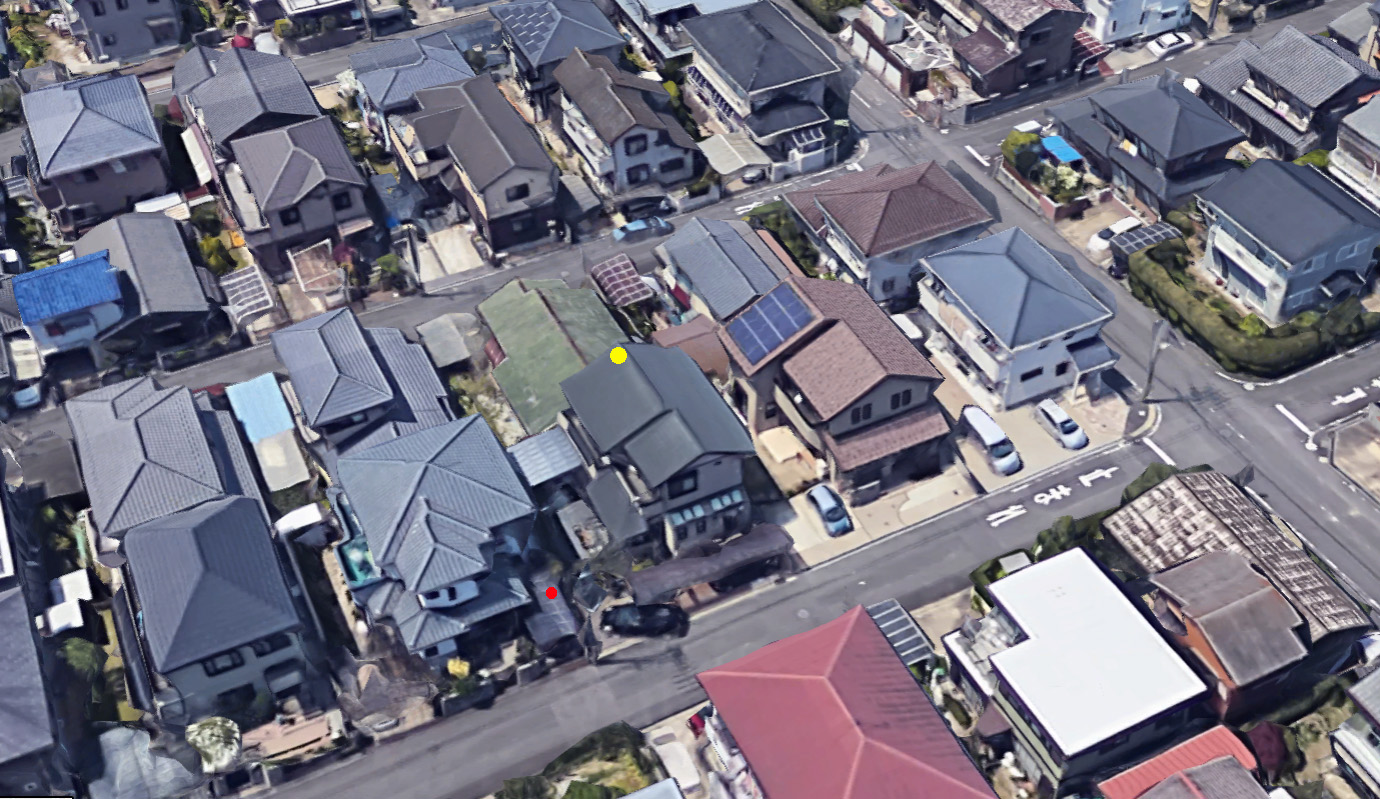
The yellow spot marks the place where the meteorite hit the house. The red spot marks the location where the 550-gram fragment hit their neighbor Mr Shingo’s carport about 14 meters away towards east-southeast. Up is west
The biggest meteorite fragment penetrated the curved transparent plastic roof of 71-year old Naito Shingo’s (內藤真吾) carport at location 35°18’38.1″N, 136°56’59.0″E then hit his ruby Toyota bB and left a shallow impact dent in its roof before it landed on the paving tiles in front of the entrance door of Shingo’s house in Komatsuji (小松寺) Komaki-Shi (小牧市). Shingo was asleep at around 10.30 p.m. when he heard a loud booming noise (ドーン) and thought there might be a thief. Nevertheless, he continued to sleep. The next morning (27 Oct.) when his wife opened the entrance door she found a fist-sized ~ 550-gram meteorite (10.5 cm (length) x 8.5 cm (width) x 4.5 cm (height)) on the paving tiles next to their carport. Initially she thought it to be a frog. Then she discovered the hole in the curved transparent plastic roof of his carport about four meters from the entrance door. Naito Shingo assumed that because of the hole in his neighbor’s roof 14 meters away the found meteorite fragment was a part of the meteorite which had first hit the roof, then rebounded, penetrated his carport’s roof and came to rest in front of the entrance door of his house. The meteorite was brought to the National Museum of Nature and Science (NMNS) in Ibaraki on October 6, where cosmogenic Na-22 and Al-26 gamma rays were detected by a pure Ge detector. It was found out that the 81-gram fragment and the 23-gram fragment fit together with the 550-gram mass. The meteorite’s name Komaki was proposed to the NomCom of the Meteoritical Society. On 19 October the National Museum of Nature and Science published a press release on the fall: PDF
On 16 February 2019 Komaki was officially registered as L6/S3 in the Meteoritical Bulletin Database. The 81-gram frament is on display at the Museum of Nature and Science (NMNS). The 550-gram main mass is on loan for display at the Museum of Nature and Science (NMNS) and from 6 April 2019 will be on permanent display at the Nagoya City Science Museum.
The two fragments found in the yard and on the garden shed
The triangular four centimeter long meteorite fragment which was found on the roof of the garden shed. Photo: nhk

The leading side of the 550-gram meteorite fragment which was found by Naito Shingo on the paving tiles in front of the entrance door. Image: CBCTV

The trailing side of the 550-gram meteorite fragment which was found by Naito Shingo on the paving tiles in front of the entrance door. Photo: home owner

The trailing side of the 550-gram meteorite fragment with its bubbly fusion crust in front of the entrance door. Photo: home owner

From 19 February to 17 March 2019 the main mass of the meteorite was exhibited together with the 81-gram fragment at the National Museum of Nature and Science. Furthermore the part of the roof on which the meteorite fell and a fragment of the plastic roof of the car port which was hit by the main mass are being presented. A microscope enabled the visitors to view a thin section of the meteorite in cross-polarized light. From 6 April 2019 the meteorite fragments is exhibited at the Nagoya City Science Museum. Photo: National Museum of Nature and Science, Tokyo
Komaki meteorite in the exhibition in the Nagoya City Science Museum. Video: CBC News
Komaki meteorite in the exhibition in the Nagoya City Science Museum. Video: ゆき
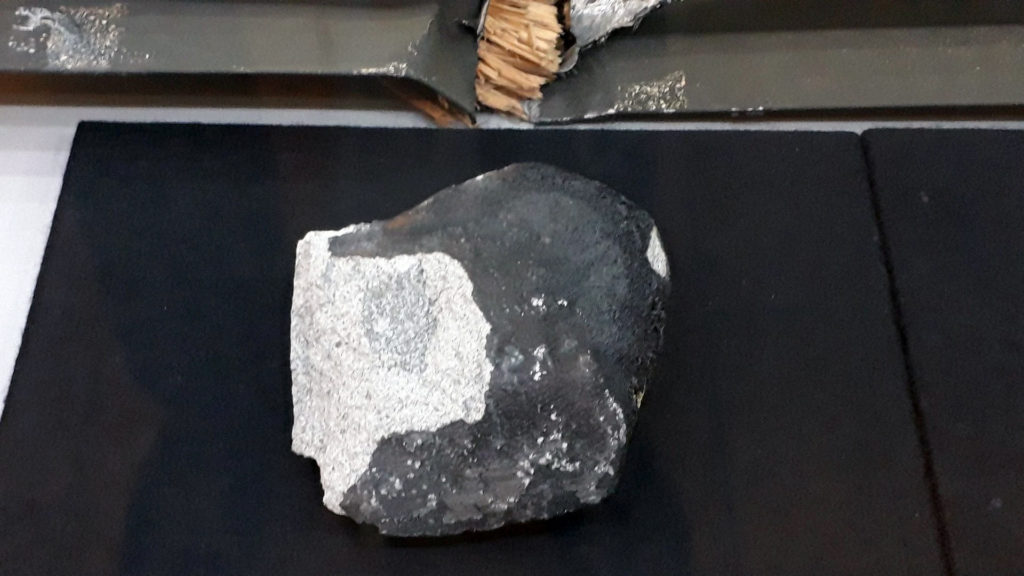
The main mass of the Komaki meteorite exhibited together with the cut out impacted roof tiles at the National Museum of Nature and Science. A part of the main mass has been cut off as can be seen on the left side of the meteorite in the photo above. This has been done for analysis and classification purposes. Photo: blog.goo.ne.jp (24 Feb. 2019)
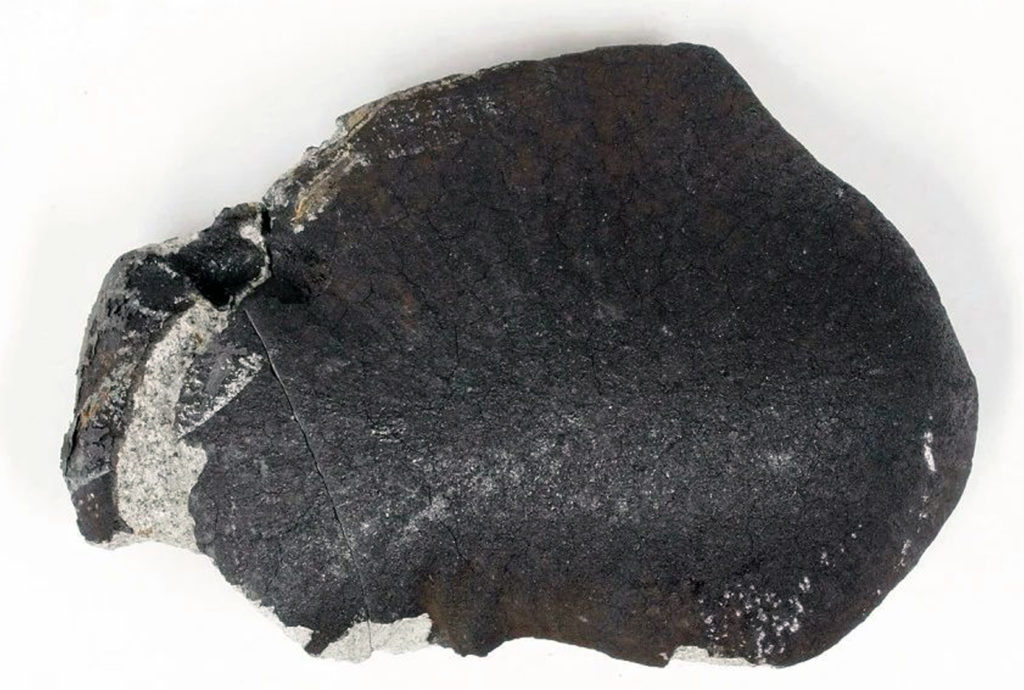

Photo: National Science Museum
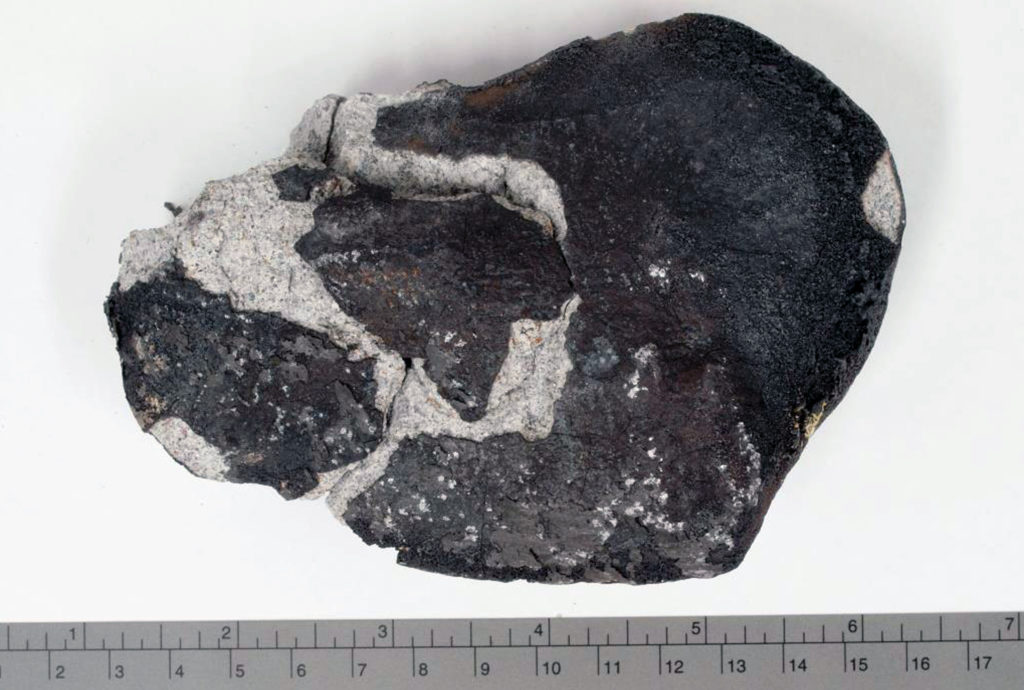
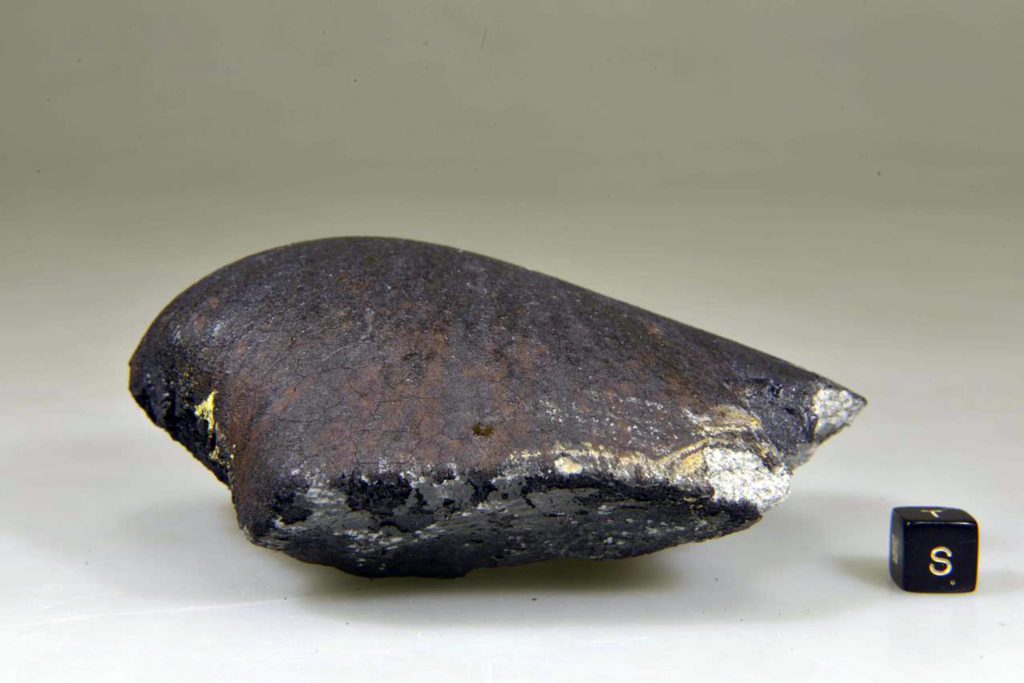

The Nagoya City Science Museum has cut out the part of the roof tiles around the impact hole to preserve and permanently expose it together with a fragment of the meteorite.
The second impact hole in the roof of the carportNational Institute of Polar Research press release (27 February 2019)
Kyushu University press release (PDF, 27 February 2019)
Media
LINK (NHK, 13 October 2018)








